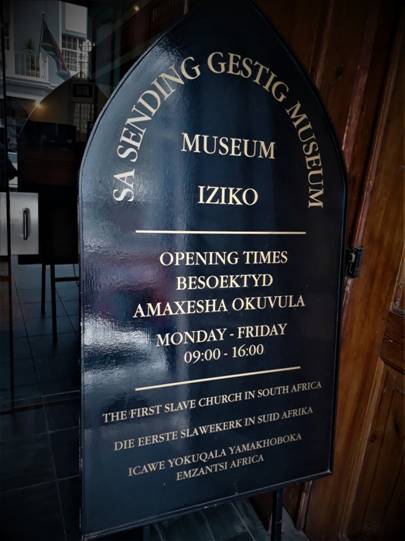
The South African Missionary Meeting House/ Sendinggestig Museum (short for the Slave Church Museum) was built between 1802 and 1804. It was founded by the African Missionary Society in 1799. The church is located in Long Street, Cape Town and is South Africa’s oldest indigenous mission church that still exists in its original structure. It is also the first official slave church in South Africa. The church was predominantly used as a space to educate slaves and those identified as non-Christians in the Cape- hence the name of the establishment. In 1802, around 280 slaves were taught literacy and religion at the church. The slaves belonging to the Dutch East India Company (VOC) in the Slave Lodge mostly gained access to the church and went on to be baptised and confirmed making them full members of the congregation. Slaves who did not attend the church were often taught in their homes or at the harbour by church goers throughout the 18th century. By the 1770s, slaves who were baptised could no longer be sold. This ruling however was not always adhered to.
The church was also used for meetings held between church directors and members as well as to preach. Sundays, in particular, were used for divine services. By 1971 the church was sold due to the poor state of the building and a new church was established in Belhar. However, in 1977 it attained heritage status and was restored by the Cape Provincial Administration. The museum is open daily and does not require anentrance fee.
The church depicts the history of mission work undertaken by South Africans. It also displays church furniture and objects, original documents, audio and visual files. The front church benches feature the names of the first eight slaves baptised at the church, and the wooden floor has a representation of stars to commemorate the abolition of slavery in 1834 in the Cape. The main exhibition consists of ten illuminated panels, which showcases the church’s history, missionary work and information about the church community. The exhibition was created by the University of Cape Town students and researchers Siona O’Connell and Nadia Kamies.
Cape Town History. (2019). Sending Gestig Church. Available online: capetownhistory.com/?page_id=455. Accessed [17/01/2020].
Cornell, C. Slaves at the Cape- a Guidebook for Beginners Researchers.Cape Town: Hansa Reproprint, 2005
Daniels, N. (2018). Exhibition honours Slave Church on 219th anniversary. Available online: www.iol.co.za/capetimes/news/exhibition-honours-slave-church-on-219th-anniversary-14600404. Accessed [17/01/2020].
Duncan, P & Proust, A. Hidden Cape Town. Cape Town: Stuik Lifestyle, 2013